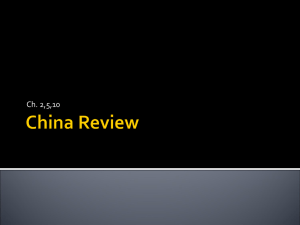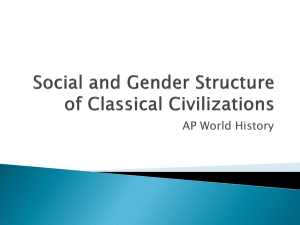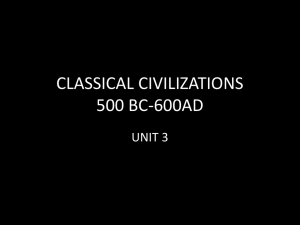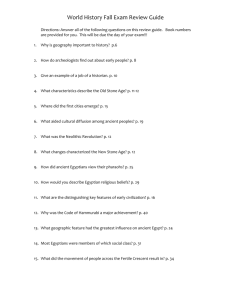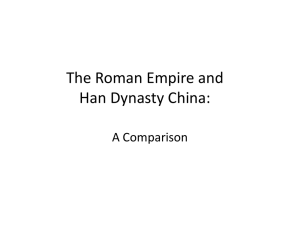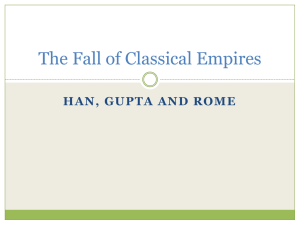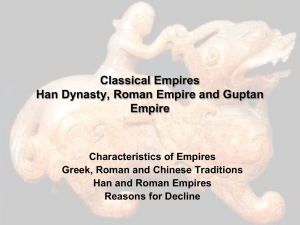WHAP EXAM REVIEW TEST #2: Classical Period Which statement
advertisement
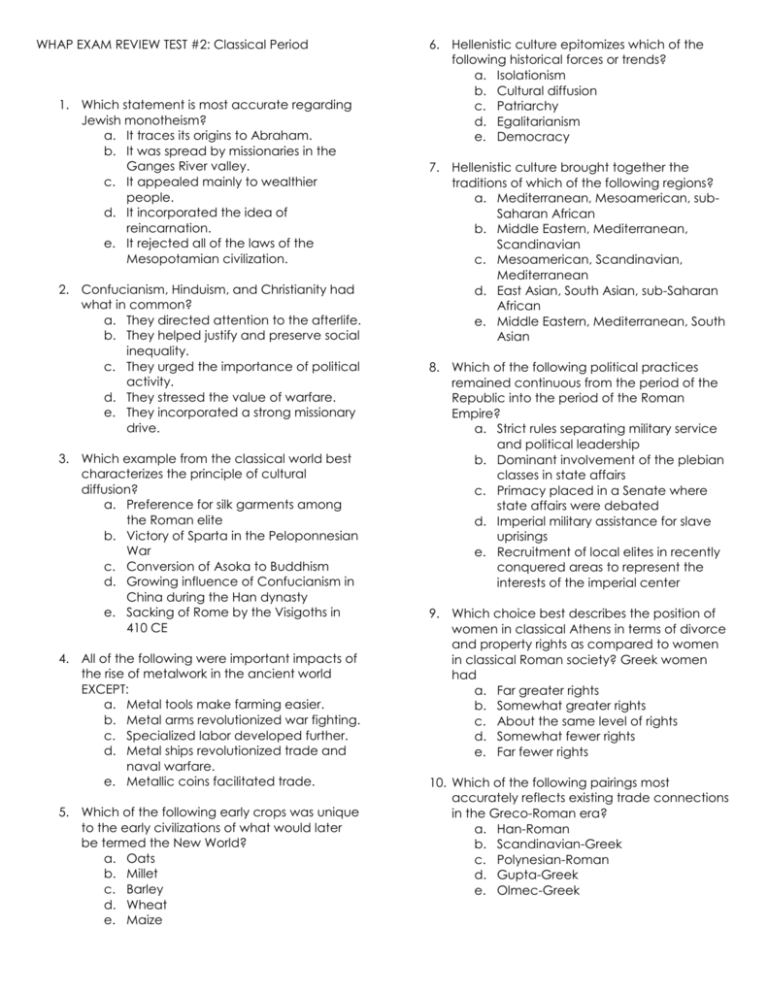
WHAP EXAM REVIEW TEST #2: Classical Period 1. Which statement is most accurate regarding Jewish monotheism? a. It traces its origins to Abraham. b. It was spread by missionaries in the Ganges River valley. c. It appealed mainly to wealthier people. d. It incorporated the idea of reincarnation. e. It rejected all of the laws of the Mesopotamian civilization. 2. Confucianism, Hinduism, and Christianity had what in common? a. They directed attention to the afterlife. b. They helped justify and preserve social inequality. c. They urged the importance of political activity. d. They stressed the value of warfare. e. They incorporated a strong missionary drive. 3. Which example from the classical world best characterizes the principle of cultural diffusion? a. Preference for silk garments among the Roman elite b. Victory of Sparta in the Peloponnesian War c. Conversion of Asoka to Buddhism d. Growing influence of Confucianism in China during the Han dynasty e. Sacking of Rome by the Visigoths in 410 CE 4. All of the following were important impacts of the rise of metalwork in the ancient world EXCEPT: a. Metal tools make farming easier. b. Metal arms revolutionized war fighting. c. Specialized labor developed further. d. Metal ships revolutionized trade and naval warfare. e. Metallic coins facilitated trade. 5. Which of the following early crops was unique to the early civilizations of what would later be termed the New World? a. Oats b. Millet c. Barley d. Wheat e. Maize 6. Hellenistic culture epitomizes which of the following historical forces or trends? a. Isolationism b. Cultural diffusion c. Patriarchy d. Egalitarianism e. Democracy 7. Hellenistic culture brought together the traditions of which of the following regions? a. Mediterranean, Mesoamerican, subSaharan African b. Middle Eastern, Mediterranean, Scandinavian c. Mesoamerican, Scandinavian, Mediterranean d. East Asian, South Asian, sub-Saharan African e. Middle Eastern, Mediterranean, South Asian 8. Which of the following political practices remained continuous from the period of the Republic into the period of the Roman Empire? a. Strict rules separating military service and political leadership b. Dominant involvement of the plebian classes in state affairs c. Primacy placed in a Senate where state affairs were debated d. Imperial military assistance for slave uprisings e. Recruitment of local elites in recently conquered areas to represent the interests of the imperial center 9. Which choice best describes the position of women in classical Athens in terms of divorce and property rights as compared to women in classical Roman society? Greek women had a. Far greater rights b. Somewhat greater rights c. About the same level of rights d. Somewhat fewer rights e. Far fewer rights 10. Which of the following pairings most accurately reflects existing trade connections in the Greco-Roman era? a. Han-Roman b. Scandinavian-Greek c. Polynesian-Roman d. Gupta-Greek e. Olmec-Greek 11. Which of the following best describes BOTH the Roman and the Han empires? a. Neither empire was linked to the Silk Roads. b. Both empires used the family as the model for state organization. c. Mounting costs associated with defending imperial frontiers led to economic and political crises. d. New religions were easily assimilated into existing imperial religious ideologies. e. Taxation of mercantile activity accounted for most government revenue. 12. What was a common feature of classical civilizations in India, China, and the Mediterranean? a. Agricultural systems dependent on monsoon rains b. Social hierarchy c. Absence of coerced labor d. Elimination of patriarchy over time e. Maintenance of highly centralized governments throughout the entire classical period 1000 BCE to 600 CE 13. What similarity did early Buddhism and early Christianity share? a. Support for caste hierarchy b. Requirement of total celibacy for men c. Allowance of women to enter monastic life d. Inclusion of Greek and Roman gods into their pantheon e. Prohibition of conversion 14. Which pair of rulers underwent a religious conversion process that had a broad-based impact on the lands under their control? a. Julius Caesar and Shi Huangdi b. Hammurabi and Julius Caesar c. Tutankhamen and Pericles d. Asoka and Constantine e. Henry VIII and Justinian 15. Which policy did both Roman and Han armies tend to implement upon taking control of a foreign land? a. Enslavement of the entire working-age population b. Repression of local worship and imposition of a state religion c. Cessation of trade contact with the rest of the world d. Construction of libraries & universities e. Relative autonomy for cooperative local elites 16. Why did the western portion of the Roman Empire suffer so much more in the breakdown of Roman imperial unity than the regions of the Eastern Roman Empire (Byzantium)? a. The feudal system in the west relied on a trade system made unreliable by harsh winters. b. The Eastern Roman world had traditionally been more economically vibrant due to more active trade links with the East. c. Popes of the Roman Catholic church maintained harmonious relations with western feudal lords. d. The Eastern Orthodox church attracted more followers than the Roman church. e. Germanic peoples migrated to Byzantium after fleeing nomadic attackers. 17. Which of the following is the most accurate statement about ancient Roman trade routes? a. On every trade route enslaved persons were the chief commodity being transported. b. Western Europe was the most profitable trade destination of the empire and had the most trade routes. c. Most trade routes were focused around the Mediterranean Sea. d. The Silk Road was Rome's most important trade route. e. Roman ships dominated the trade of the Indian Ocean. 18. Which weakness of the Roman Empire contributed most directly to its collapse? a. It was too vast to impose unity and order among all of the regions. b. Mountain ranges blocked effective transport and communications between key areas. c. It was too small to marshal resources necessary to protect itself from rival powers. d. Repeated incursions into the territories of powerful empires to the east resulted in devastating offensives. e. It did not have access to waterways suitable for carrying out Iong- distance trade. 19. Which of the following civilizations afforded the greatest degree of citizen input into government policy? a. Han b. Roman c. Sumerian d. Egyptian e. Gupta 20. In Greek civilization, women a. Held slave status in every household b. Enjoyed political equality with men c. Were afforded the same rights no matter the city-state in which they happened to reside d. Dominated trade e. Were considered inferior to men in both the private and public spheres 21. Christianity's rise is most accurately viewed as a modification of which of the following? a. Islam b. Hinduism c. Judaism d. Confucianism e. Buddhism 22. The geographic factors presented here led to the development of which highly complex and distinctive civilization by the year 600 CE? Fertile river valleys Isolating mountain ranges Dependable monsoon weather patterns a. Indian b. Roman c. Mayan d. Sumerian e. Greek 23. Which of the following best describes political patterns on the Indian subcontinent in the classical era 1000 BCE to 600 CE? a. Stateless societies b. Continuous dynastic rule under the Maurya Empire c. Decentralized rule by local princes lacking any form of subcontinent-wide authority at any point d. Decentralized rule by local princes punctuated by Maurya and Gupta periods of unification e. Representative democracy 24. Which was the most effective unifying force in early Indian culture? a. Long-distance trade with East Asian civilizations b. Widely practiced and similar Hindu tradition, including the caste system c. Expansion of Buddhist influence d. Recognized central political authority e. Matriarchal patterns of social authority 25. Which major world religion lacks a central founding figure? a. Christianity b. Islam c. Judaism d. Buddhism e. Hinduism 26. Which is NOT a significant continuity Buddhism carried over from its Hindu roots? a. Endorsement of caste stratification b. Belief in an afterlife c. Concern with and reverence for beauty in nature d. Ornate temple architecture e. Centrality of ritual in worship 27. Which of the following ancient texts did not serve as a spiritual guide for those who lived by it? a. Vedas b. Analects c. Torah d. New Testament of the Bible e. Koran 28. Which important idea is credited to intellectuals of the Gupta Empire? a. Invention of the telescope b. Development of humanity's first written script c. The concept of zero d. Invention of the magnetic compass e. Polytheism 29. Which beliefs do Hinduism and Buddhism have in common? a. Belief in the caste system b. Damnation for sinners c. Reverence for Muhammad d. Monotheism e. Reincarnation 30. Which lasting pattern in the history of the subcontinent can we trace to the period of the rule of the Maurya and Gupta empires in India? a. Strong state sponsorship of Hindu beliefs b. Invasion and rule by nomadic invaders c. Difficulty in maintaining centralized imperial rule d. Long and generally unbroken eras of centralized imperial rule e. Coexistence with Islamic rule and culture 31. Why did long-distance trade flourish in the classical world? a. Stable imperial authority provided safe passage for merchants. b. Circumnavigation of the globe by the Romans increased access to goods from distant lands. c. Silk Roads were so safe that individual traders frequently traveled their entire distance. d. Stable central rule in India throughout the period made it a vital hub of trade. e. Bantu migrations helped establish a common linguistic bond across the Eurasian landmass. 32. Which statement comparing classical Chinese civilization with contemporary Western civilization is most accurate? a. The Chinese economy relied on slavery to a greater extent than Western civilization did. b. China set an enduring pattern of more sophisticated agricultural, metallurgical, and textile production techniques than Western civilization. c. Women had markedly greater maneuverability within Chinese civilization to achieve positions of high social status. d. The Chinese developed a simplified phonetic writing system similar to Hebrew. e. In China agriculture was replaced by handicraft manufacturing as the main economic base of society. 33. Which of the following was NOT a tactic used by Shi Huangdi to unify China into one empire? a. Relying mainly on diplomacy and not military force to achieve territorial expansion b. Appointing bureaucrats to rule the provinces, displacing regional aristocrats c. Building the Great Wall to guard against invasion d. Establishing uniform currency and measurements e. Employing legalism as the state political philosophy 34. Which choice best captures the main difference between legalist and Confucian beliefs? a. Legalism relied on harsh laws to maintain order while Confucianism depended on rituals, customs, and obligations rooted in family relations. b. Legalism never became state doctrine while Confucianism did under the Han dynasty. c. Confucianism never became state doctrine while legalism did under the Qin dynasty. d. Legalism's complex formulas for achieving spiritual enlightenment took greater root among the masses than the Confucian emphasis on achieving inner peace through unity with the natural world. e. Legalism emphasized egalitarian class relations while Confucianism was more concerned with maintaining established hierarchies. 35. Which of the following was NOT a lasting feature of Chinese civilization formed by the later Zhou era? a. Origin and early spread of a Daoist worldview b. Dynastic rule and the conception of the Mandate of Heaven c. Intensive river valley irrigation and agriculture d. Confucian social prescriptions to guide family and state-subject relations e. Significant Buddhist penetration and influence among the broad masses of the people 36. Confucian thought falls most neatly into which of the following categories? a. Conservative political philosophy aiming to preserve a hierarchical status quo b. Prophetic millennial ideology preparing the masses for an impending judgment day c. Spiritual guide to gaining salvation for the individual's eternal soul d. Revolutionary ideology aimed at dismantling social hierarchy e. Set of moral precepts designed to promote a more harmonious union between man and nature 37. Which of the following best describes how Chinese imperial elites viewed their civilization in relation to the rest of the world? a. China was a unique and superior civilization surrounded by barbarians of one sort or another. b. China was an intermediary civilization whose main role was to facilitate the exchange of trade items and ideas between surrounding and more advanced societies. c. China was one member of a peer group of advanced civilizations. d. China was a great civilization trapped in an irreversible decline due to nomadic invasion and inability to support massive population growth. e. China was a rising civilization learning from and preparing to overtake existing world powers. 38. Confucianism differed from Hinduism in that a. Confucianism held women as subordinate to men. b. Confucianism detailed the levels of the social hierarchy in more specific terms. c. Confucianism more clearly outlined guidelines for behavior. d. Confucianism was more oriented toward religious devotion and the hereafter. e. Confucianism emphasized earthly obligations without regard to concerns relating to afterlife and rebirth. 39. Which is the closest similarity between the Roman Empire and the Han dynasty of ancient China? a. Both aimed for and experienced long periods of isolationism in world affairs. b. Both created a government run by elected officials known as Senators. c. Both achieved long periods of centralized government and expanding economies. d. Both rejected social hierarchy. e. Both afforded women equal opportunities to wield political power as men. 40. One major difference between the fall of Han China and that of the Roman Empire was a. Dynastic China would return to equal and even greater prominence. b. The Roman Empire left little basis for subsequent developments in Western civilization. c. The Roman Empire collapsed due to multiple causes while Han China fell to peasant unrest alone. d. Han China adopted a new state religion in its later phase while the Roman Empire did not. e. Roman imperial blunders can be traced to decisions made in a Senate, not by emperors. 41. In Chinese tradition, the Mandate of Heaven refers to a. Chinese ethnocentric tendencies b. Eternal authority of a ruling dynasty c. Divine blessing of the rule of an emperor d. Belief in many gods e. The goal of Buddhist meditation 42. In which of the following periods of Chinese history did Confucius live? a. Qin dynasty b. Late Zhou dynasty "Era of Warring States" c. Han dynasty d. Sui dynasty e. Shang dynasty 43. Which of the following is true for both the Qin and Han dynasties? a. State policy was shaped by Confucian precepts. b. Imperial authority was strong in the opening years of each. c. Merchants were held in high regard. d. Trade was not economically important. e. Nomadic invaders toppled each one. 44. Daoist thought tends to emphasize a. Respect for the emperor b. Harmony with nature c. Authority of the father d. The struggle of the poor for justice e. Punishment for sin 45. Which of the following was NOT a state concern in Han China? a. Expanding educational opportunity for elite women b. Sponsorship of scientific inquiry c. Maintenance of the Great Wall d. Grain requisition from the peasantry e. Suppression of banditry 46. Daoism was never a threat to dynastic rule because a. Daoist doctrine held that the emperor was holiest of all. b. Daoists believed the natural order required exploitation of the peasantry. c. Daoist religious leaders became the main advisors of the scholar-gentry. d. Daoist detachment from human affairs blunted the possibility of political threat. e. Daoists abandoned their faith in favor of Confucianism over time. 47. The main pattern in Chinese art established by the close of the classical era was a. A focus on monumental building b. High levels of craftsmanship and attention to detail work c. High Reverence of the female physical form d. Preference of marble over jade in small sculptures e. Representation of the peasantry Answers: 1. 2. 3. 4. 5. 6. 7. 8. 9. 10. 11. 12. 13. 14. 15. 16. 17. 18. 19. 20. 21. 22. 23. 24. 25. 26. 27. 28. 29. 30. 31. 32. 33. 34. 35. 36. 37. 38. 39. 40. 41. 42. 43. 44. 45. 46. 47. A B A D E B E E E A C B C D E B C A B E C A D B E A B C E C A B E A D A A E C A C B B B A D B

